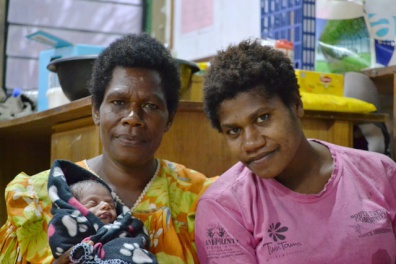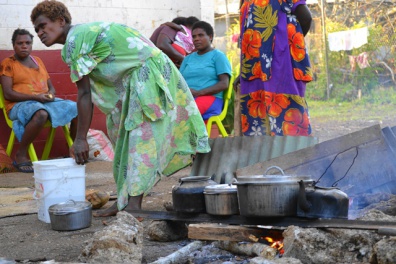Cyclone Pam evacuation centers home to new-born
Cyclone Pam evacuation centers home to new-born
UNFPA Pacific, Port Vila, Vanuatu (March
25, 2015) - As her family settled into one of the classrooms
at Freswota Primary School in Cyclone Pam-stricken Port
Vila, in the Pacific island nation of Vanuatu, Meri Yalu was
more troubled by an impending birth rather than the
storm.
The truck driver that transferred the group to the
school agreed, to her great relief, to transfer her daughter
Adelila Yalu to the Port Vila Central Hospital as
contractions began to become more pronounced.

It was to be the beginning of a
harrowing night for the first mother: her first born was
going to enter the world feet first: a breech birth. The
teenager birthed her daughter naturally, at the height of
Cyclone Pam: with no power and in a flooded theater.
Adelila smiles shyly when approached for her story and
picture, breastfeeding baby Pamina - named for the cyclone
that raged outside on her arrival by the woman who ran the
evacuation center Pamina and her family call home, for now.
Manses and Regina Kalo appear calm for a couple who are
managing one of the main evacuation centers opened for
Cyclone Pam in the Pacific island nation Vanuatu.
It is by
default of Mr Kalo's position as school principal of Ecole
Primaire de Freswota that the couple who are both teachers
found themselves managing the influx of people fleeing to
the school for shelter on the night of March 13.
The
Kalos had time to count 750 people into the school before
they had to return home to prepare their family for the
brunt of Cyclone Pam - the family which lives in the school
compound awoke to alittle over 1000 people.
Mr Kalo said
most of the families were subsistence farmers; apart from
losing their homes, the families are now facing financial,
food and water security issues for the next few
months.
"Some of them went straight back to their areas to assess the damage to their homes; men started rebuilding with whatever they had immediately and replanting. Some have moved back but it will now be about basics - food and water," Mr Kalo said.
"Some came with nothing but the clothes on their back. They are in need of assistance and this is why it has been good that some non-government organizations came early with some basics."
The couple run a tight ship; they are well aware of the potential for violence in situations where as many as 50 people share a classroom. A roster of duties has been formulated and Mrs Kalo walks through the school every morning to ensure a level of hygiene is maintained.
"The majority of those who
came were women and there were more than 10 expectant
mothers; one was born in the night of the cyclone and
another was rushed to hospital the next day," Mrs Kalo said
as she walked UNFPA through the school which while not full
to capacity, was still filled with evacuees.
"I encourage
them to sun their beddings and maintain clean bathroom
facilities. At 9pm every night, we close the gates."
A 2012 study on the prevalence of violence against in Vanuatu reported 60 per cent intimate partner violence and 48 per cent non-partner violence. Gender-based violence (GBV) can be exacerbated in emergency evacuation centers and host-family accommodation. Vanuatu civil society partners had concrete and safe ways for supporting GBV prevention and response.

"We know there are high incidences
of GBV from the 2012 Family Health and Safety Studies. We
are monitoring this aspect very carefully because if women
are not reporting or unable to access health care then we
want to understand what the barriers are and be able to
respond," Maha Muna, UNFPA Gender Adviser said.
The NDMO notes that evacuation centers have begun to shut down as people return home; 35 remain open, housing over 3000 people. UN agencies, coordinated by the Gender and Protection Cluster, are supporting the Government to ensure safe, informed and voluntary return.
Based on the findings of the 2013 Demographics Health Survey, the United Nations Population Fund (UNFPA) estimates there are 56,000 women of reproductive age of which 6700 are estimated to be pregnant. It's estimated that 300 women may experience pregnancy-related complications over the next three-month period.
ENDS


 Burness: At COP16, Indigenous Peoples & Local Communities Await Final Word On Decisions Impacting World’s Most Biodiverse Regions
Burness: At COP16, Indigenous Peoples & Local Communities Await Final Word On Decisions Impacting World’s Most Biodiverse Regions UN News: Deadly Floods In Spain Highlight Need To Cut Greenhouse Gas Emissions
UN News: Deadly Floods In Spain Highlight Need To Cut Greenhouse Gas Emissions Deep Sea Mining Campaign: New Report Exposes Risks In Digital Twin Technology For Deep Sea Mining
Deep Sea Mining Campaign: New Report Exposes Risks In Digital Twin Technology For Deep Sea Mining Pacific Islands Forum Fisheries Agency: Operation Kurukuru - Joint Forces Combat IUU Fishing To Secure Sustainable Fisheries Future
Pacific Islands Forum Fisheries Agency: Operation Kurukuru - Joint Forces Combat IUU Fishing To Secure Sustainable Fisheries Future Save The Children: World More Dangerous Than Ever For Children With Crimes In Conflict At Highest Ever In 2023
Save The Children: World More Dangerous Than Ever For Children With Crimes In Conflict At Highest Ever In 2023 John P. Ruehl, IMI: Which Countries Are On The Brink Of Going Nuclear?
John P. Ruehl, IMI: Which Countries Are On The Brink Of Going Nuclear?